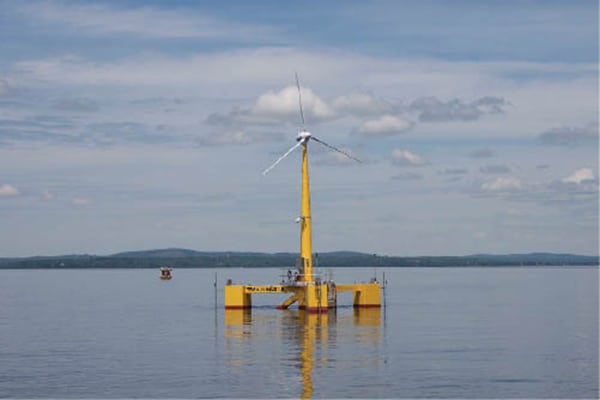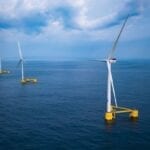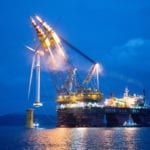A prototype 100-kW floating wind turbine that has been tested off Nagasaki near Japan’s Kabashima Island since May 2012 is slated to be replaced by a full-scale, grid-connected 2-MW wind turbine this fall. The demonstration backed by Japan’s Ministry of Environment, Kyoto University, Fuji Heavy Industries, Toda Construction, and the National Maritime Research Institute of Japan features a floating spar buoy wind turbine built by Japan Steel Works and Hitachi. Following initial operation and data collection, the project will be upgraded to a Fuji Heavy Industries 2-MW wind turbine. The project will mark a major point of progress for the world’s infant deep water offshore wind industry.
According to a new report from the European Wind Energy Association, at the end of 2012, 1,662 turbines totaling 5 GW of installed offshore wind capacity were spread across 55 wind farms in 10 European countries. But, with the exception of two turbines, Europe’s grid-connected offshore wind turbines rely on fixed foundations, and the vast majority of those are on monopile foundations, the organization notes. Gravity-based substructures are the second-most-common foundation type, followed by space frame structures. Only Statoil’s 2.3-MW Hywind project—the world’s first large-scale floating wind structure installed in 2009 in Norway—and the 2-MW Windfloat, installed off the Portuguese coast in 2011 by Principle Power and EDP, are installed on floating substructures.
At least six experimental floating structures are in a test phase globally: SeaTwirl, SWAY, Blue H, and Poseidon in Europe; the WindLens in Japan; and the DeepCwind floating turbine in the U.S. Another 35 designs for water depths of more than 50 meters are under development worldwide. The majority (60%) are located in Europe, 10% are in the U.S., and 23% are in Japan.
Experts say deep water offshore wind potential in the U.S. is immense, owing to long coastlines and a good wind resource, but there are no offshore wind farms operating to date. In May 2013, the University of Maine and the DeepCwind consortium—comprising 30 companies—put online the first 20-kW prototype (Figure 3). Also, the Department of Energy has announced $168 million in funding over the next six years for seven offshore wind demonstration projects—including three floating projects.
In Japan, which has the world’s sixth-largest Exclusive Economic Zone and a long maritime heritage, more than 80% of offshore wind energy resources are located in deep waters. The country’s government has been funding research on deep offshore structures for more than two decades, but interest has kicked up since the March 2011 Fukushima nuclear accident as the government focuses on putting online more renewables. An estimated 5 GW to 6 GW have been envisioned for the country by 2030.
Including the prototype WindLens project in Hakata Bay—which features two wind turbines of just 3 kW each—at least three national offshore wind projects have been announced, one of which could use a floating substructure. That project is supported by Japan’s Ministry of Economy, Trade and Industry and involves a $250 million demonstration off the coast of Fukushima. Plans call for the installation of several floating offshore turbines, including three types of floating substructures with two different turbine sizes: 2 MW in phase 1 and 7 MW in phase 2. The Fukushima offshore project is being developed by an industry consortium led by Marubeni Corp. and includes Mitsubishi and Hitachi. Mitsubishi has, meanwhile, announced plans for the development of a new 7-MW turbine with a hydraulic drive, designed to operate on semi-submersible floating platforms in deep water off the coast of Fukushima. Among the consortium’s ambitious goals are to reach 1 GW of floating capacity.











